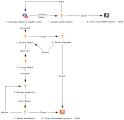ALM - Defect Template with Quality Center Integration Workflow
The PPM workflow that ALM provides for integration with QC/ALM project defects is the ALM - Defect Template with Quality Center Integration workflow, which includes execution steps to create a defect or requirement in QC/ALM. You can use this workflow as a template for creating your own workflows.
Note: Although you can create new workflows from scratch, we recommend that you create them from this template. To create a new workflow, use the PPM Workbench to create a copy of a provided workflow, and then modify the copy (add, delete, or change its steps) to suit your needs.
The integration also uses the ALM - Release Request workflow to create a release entity that includes several requests for change. This workflow can be used for ITIL purposes whether or not PPM is integrated with other applications. For more information, see ALM - Release Request Workflow.
The ALM - Defect Template with Quality Center Integration workflow is used to create a defect and to track how the defect is resolved. See the following figure and workflow step 5, Defect Verification.
Figure 6-2. ALM - Defect Template with Quality Center Integration workflow
When a request of type ALM - Defect Template with Quality Center Integration is created in PPM, the first step in the workflow creates a defect in QC/ALM. Subsequent steps cause the defect status in QC/ALM to change to Open, Reopen, Fixed or Closed, depending on the stage in the PPM workflow.
Types of Workflow Steps
As with any PPM workflow, the ALM - Defect Template with Quality Center Integration workflow can contain the following types of steps:
-
Decision steps. Steps that require action from the user in order to proceed. When the user reaches the decision step, the user sees a set of choices. Each choice causes the workflow to proceed in a different manner. For example, at one decision step in a workflow, a project manager might be offered the choice of either deploying a package or sending it back to QA for more testing.
-
Condition steps. Steps that determine the direction that the workflow takes.
-
Execution steps. Steps that are automated through PPM. For example, an execution step might create a requirement or defect in QC/ALM, execute a script, or run a build.
ALM provides two execution steps that can be used in PPM to build a workflow for integration of PPM with QC/ALM. The execution steps create a defect or a requirement in QC/ALM.












